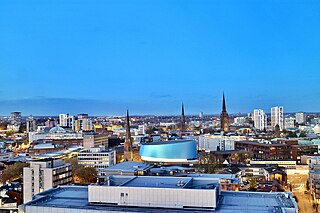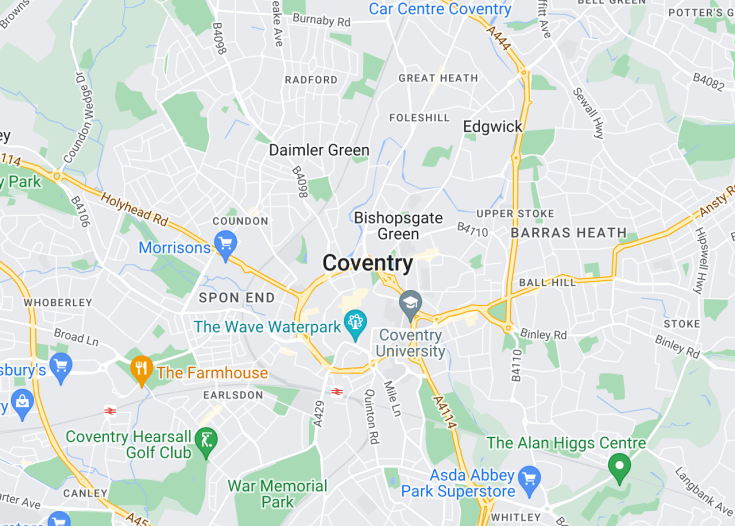Coventry, a city rich in medieval history and cultural heritage in the heart of England, tells a story of resilience and renewal. It boasts the awe-inspiring Coventry Cathedral, famed for its striking modernist design alongside the ruins of its predecessor, destroyed during World War II. The city’s vibrant arts scene, museums, and yearly events like the Coventry Motofest celebrate its automotive heritage. Coventry, a former UK City of Culture, offers an array of historical insights, green spaces, and an innovative spirit.
When visiting Coventry, make sure to explore the Coventry Transport Museum to delve into the city’s significant influence on the British motor industry.
Consider timing your visit to coincide with the Coventry Peace Festival, which offers various events promoting peace and reconciliation.
Top things to do & see in Coventry
Select the following sights and activities to discover best tickets and tours available in Coventry.
Coventry: A City of Innovation and Resilience
| Country | England (United Kingdom) |
| Time in Coventry | GMT+0 |
| Language spoken | English |
| Population | 371,521 (source: Office for National Statistics, 2021) |
| Currency | British Pound (£, GBP) |
| Airports |
|
Coventry, a city set in the heart of England, holds a unique position in both historical and modern narratives of the UK. Known for its pivotal role during the Industrial Revolution, Coventry was once a major hub for the textile and watchmaking industries and later became prominent for manufacturing bicycles and cars. Today, its innovative spirit is echoed in its bid to be a leader in green energy and automotive technology, maintaining its reputation as a catalyst for economic and cultural development.
Celebrated for its resilience, Coventry suffered extensive damage during World War II, particularly during the Blitz. The city’s rebuilding efforts are epitomized by the modernist architecture of the new Coventry Cathedral, built next to the ruins of the old, symbolizing peace and rebirth. Coventry was also the UK’s City of Culture in 2021, bringing light to its vibrant arts scene which features music, theater, and visual arts, deeply rooted in diversity and innovation.
The city is not just about the past; it is a venue for cutting-edge research and development in various sectors such as electric vehicles and sustainable technologies. Coventry University and the University of Warwick contribute heavily to its academic atmosphere, creating a thriving community of students, academics, and professionals focused on advancements in science and technology.
Moreover, the Ricoh Arena, a stadium with a capacity of 32,609, serves as a center for sporting events, concerts, and business conferences, exemplifying Coventry’s versatile community facilities. From its rich history of manufacturing to its dynamic present in digital technologies and sustainability, Coventry continues to make a significant impact globally.
Where is Coventry?
Located in the West Midlands county of England, Coventry is strategically near major cities like Birmingham and Leicester.
Distances:
| Route | Distance by car | Time by car |
|---|---|---|
| Coventry to London | 95 miles | 2 hours |
| Coventry to Birmingham | 19 miles | 40 minutes |
| Coventry to Manchester | 101 miles | 2 hours 10 minutes |
What is Coventry famous for?
Coventry is famed for its pioneering role in the British motor industry, historical landmarks like Coventry Cathedral, and cultural richness, notably its status as the UK’s City of Culture 2021.
History
Pre-Medieval Era
Coventry, located in the West Midlands of England, has a history that stretches back to ancient times. Originally believed to be a settlement during the Bronze Age, it later became established as a significant area during the Roman occupation owing to its proximity to the Fosse Way, an important Roman road. The name “Coventry” originates from the Anglo-Saxon “Cofantre,” meaning “tree of Cofa,” indicating a likely personal or tribal name coupled with the Old English “tre” (tree), signaling a meeting place or prominent landmark.
1043 – Middle Ages
Coventry’s significant development came in 1043 when Leofric, Earl of Mercia, and his wife Lady Godiva founded a Benedictine monastery on the site of today’s St Michael’s Cathedral. This period precipitated the growth of Coventry as a center of commerce and spirituality. The city was granted a charter in the 12th century, fortifying its status as a market town and later became a hub for the wool and cloth trade, making it one of the wealthiest cities in medieval England. Its reputation was marked by the construction of its magnificent St. Mary’s Guildhall in the 14th century.
1500s – 1940s
Throughout the Tudor period, Coventry continued to flourish economically due to its burgeoning textile industry. However, the city faced significant challenges during the English Civil War due to its strategic importance, enduring multiple sieges. By the Industrial Revolution, Coventry adapted by shifting its focus toward watchmaking and later automotive and bicycle manufacturing, establishing itself as a pivotal industrial city. The 20th century, particularly the Second World War, marked a profound period for Coventry due to the devastating blitz in 1940 that almost obliterated its historic city center and cathedral.
Post-War Reconstruction – Present
Post World War II, Coventry underwent extensive rebuilding, embracing modernist architectural designs and becoming a symbol of hope and renewal. The new St Michael’s Cathedral, consecrated in 1962 next to the ruins of the old, stands as a monument to peace and reconciliation. In recent decades, Coventry has diversified its economic base, enhancing its educational and cultural institutions, and in 2021, it proudly held the title of UK City of Culture, hosting a multitude of cultural events that celebrated its rich and diverse heritage and community.
Visit Coventry
What to see and do in Coventry
Visitors to Coventry will find a blend of historic charm and modern vibrancy. Key attractions include:
- The Coventry Cathedral, including the ruins of the old cathedral and the modern structure, symbolizing resilience and peace.
- The Coventry Transport Museum, showcasing the city’s industrial past with collections of bicycles and motor vehicles that played a significant role in its development.
- St. Mary’s Guildhall, an exquisite example of medieval architecture loaded with history, including connections to Mary, Queen of Scots.
- The Herbert Art Gallery and Museum, offering insights into the art, history, and culture of Coventry.
- War Memorial Park, a lush, expansive area ideal for relaxation and remembering those who served during the World Wars.
Annual Events in Coventry
Coventry hosts various events year-round that reflect its cultural richness. Notable among them are:
- The Coventry MotoFest, an annual celebration of the automobile industry, taking place in the summer, energizing the city with motor-themed exhibits and performances.
- The Godiva Festival, inspired by the legend of Lady Godiva, is the largest free family music festival in the UK, held in July.
- Coventry Peace Festival held in November, emphasizing the city’s dedication to reconciliation and world peace.
Best time to visit Coventry
The best times to visit Coventry are late spring (May and June) and early autumn (September and October). During these periods, the weather is mild, and the city is less crowded, allowing you to fully enjoy its outdoor sites and events.
Is Coventry worth visiting?
Coventry is undoubtedly worth visiting for its unique blend of historical significance and contemporary culture. The city offers an impressive array of attractions from the poignant history of its cathedrals to its vibrant arts and cultural scenes. As a recent UK City of Culture, Coventry has proven its capacity to celebrate its rich heritage while dynamically moving towards the future, making it a fascinating destination for all types of travelers.









